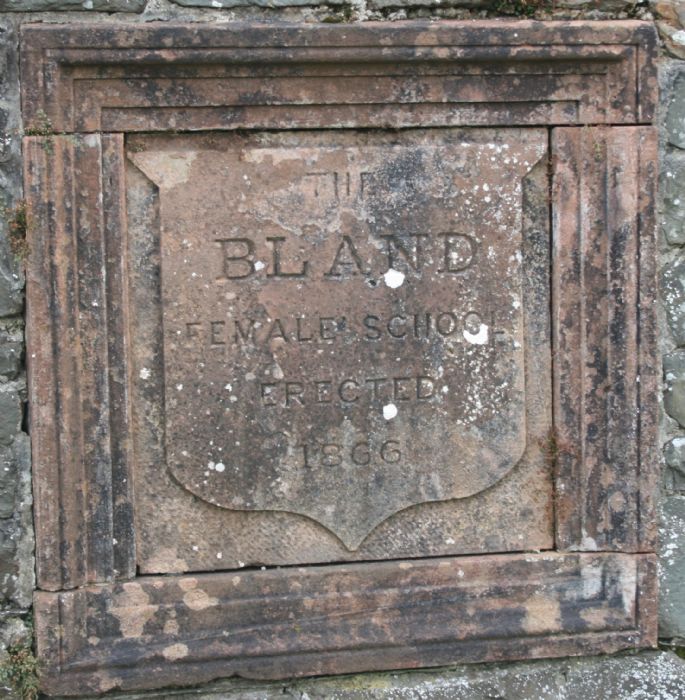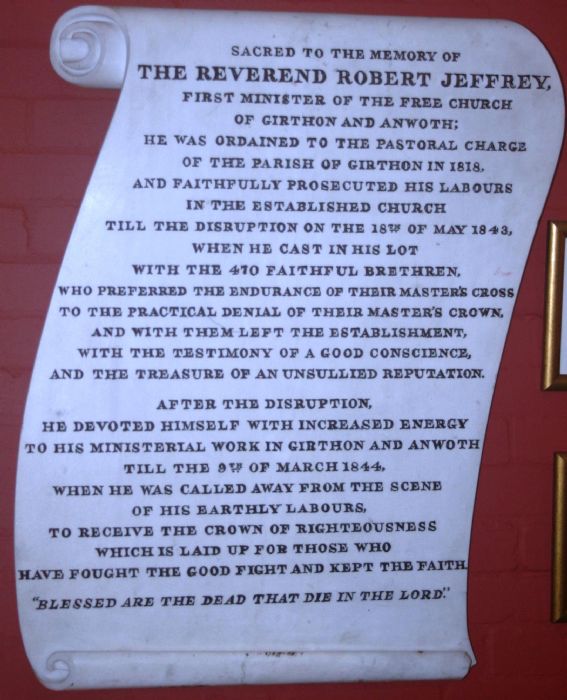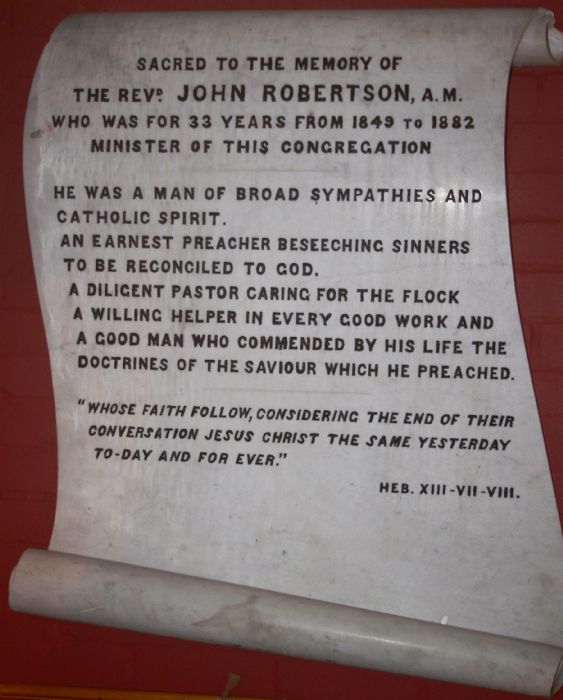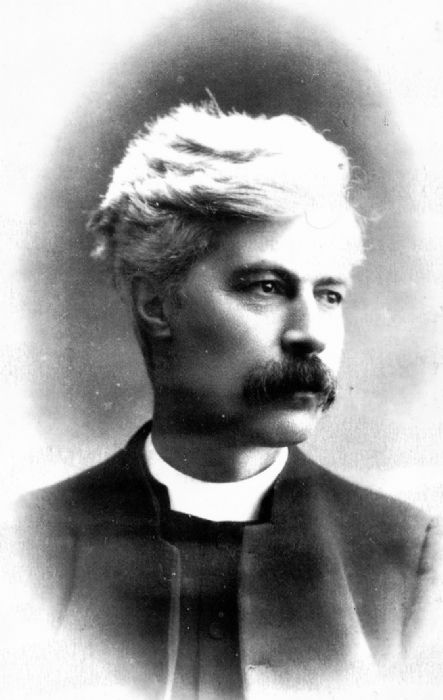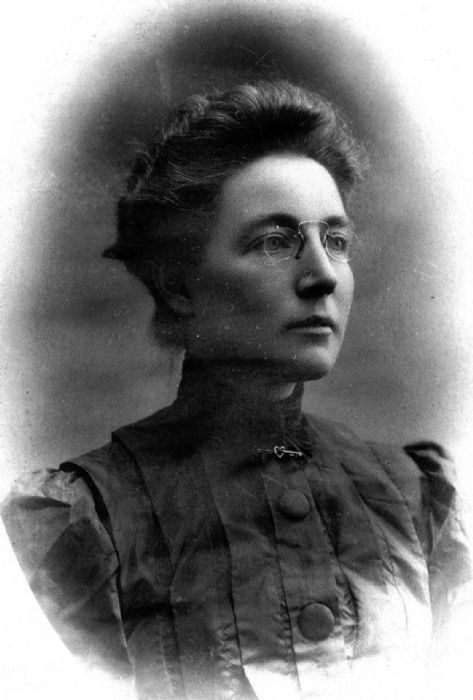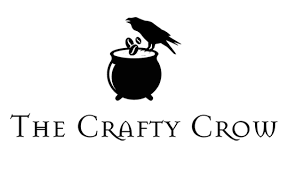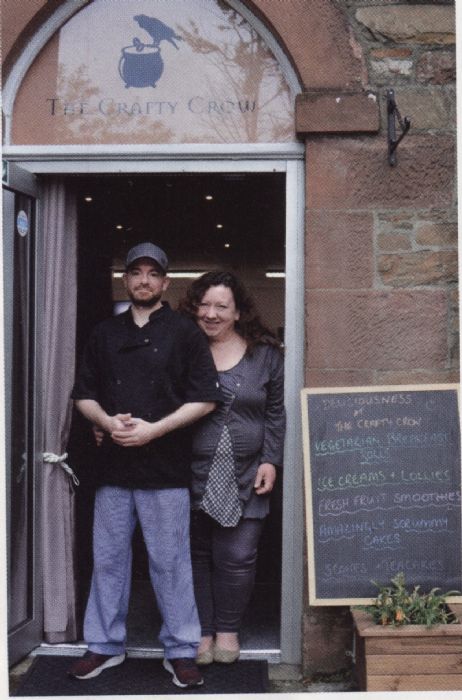
In 1843, Robert Jeffrey who had been the minister at Girthon Parish Church since 1818, became the first minister of the newly-formed Free Church of Scotland in Gatehouse. Congregations initially met in the Masonic Hall in Ann Street, until what is now the Rutherford Hall was opened in 1844. Sadly Rev Jeffrey died on 4th March 1844 before the new church was completed.
Building the ChurchThe land used for the new church was on the Girthon bank of the River Fleet, beside the Fleet Bridge, close to the boundary between Anwoth and Girthon parishes. The foundation stone was laid on 24th April 1844 by Rev. Samuel Smith form Borgue. Unusually the church was built on a north/south axis - usually churches face east/west.
The whinstone (freestone) came from Ardwall Island (Laurie's Isle) in the Fleet Estuary. The bay where the stone was loaded onto a barge to be taken from the island is still known as Free Church Bay. The sandstone lintels came from the Castramont Burn above Culreoch Cottages. It is believed that the original building may have had a single peaked roof. This proved unstable so pillars were extended from ground level up to the eaves to support a roof with two smaller peaks. The ground floor doors opened onto the street beside the bridge while a basement area opened onto the river bank.
The church was formerly opened by Rev Mr McAuley of Donaghadee on 8th December 1844. According the Dumfries & Galloway Standard 11th Dec 1844, the building was designed to house 500 people.
The bell, which is inscribed 'David Burges - Founder - Glasgow 1841' which was used in the tower of the church was cast in 1841 and was originally was in the nearby Birtwhistle Cotton Mills to signal workers when to start and finish their days work. About 1850, after the mill was destroyed by fire, the bell was installed in the Free Church tower.
Inside, the church had a simple design. As well as the usual pews there were box pews to the right and left of the pulpit - the minister's family having one, and the Ardwall estate, who supported the Free Church had another.
|
The Free Church of Scotland preferred simple services and a strict religious code, including fast days. Only psalms from the Old Testament were 'sung' unaccompanied. It was not until after 1900, when Rev. McGlashan was minister, that the congregation voted to allow singing of hymns in the church, but without musical instruments.
|
Girthon Manse - Planetree Park |
In 1849 the Free Church asked for tenders to build a manse for the minister. The house was built at the west end of the town at Planetree Park.
The Free Church also ran schools for the children of their parishioners. In Gatehouse it is believed that 'The Bland Female School' which opened in Dromore Road in 1866, was a Free Church School. A boys school was probably housed in the other half of the same building. David Clark, the Free Church School headmaster, was living in the schoolhouse in the 1871 Anwoth census. The schools closed when they joined with Anwoth Parish School in 1872.
(It is not known who sponsored the 'Bland' school. See section on David Clark - click here
In 1900 the United Presbyterian Church which used the church building on Dromore Road, known locally as the Wee Kirk, joined with the Free Church of Scotland to form the United Free Church of Scotland.
For about 5 years the 2 congregations seemed to continue to worship in separate buildings - the Anwoth people continued in their Dromore Road Church, the Girthon people in the Free Kirk, known as Girthon United Free Church.
In 1905 about 55 members of the Anwoth Free Church joined the 80 Girthon Free Church members. This new church became known as Rutherford Church with the joint congregation using the Free Church building. Rev. McGlashan was still the minister.
Rev. Robert Blackstock McGlashan was the last minister of the church. His gravestone at Anwoth states that he was minister of Girthon and Anwoth U.F. Church, latterly Rutherford Church, for 48 years.
In 1929 the Free Church of Scotland and the Church of Scotland resolved their differences and again joined forces. However in Gatehouse this did not happen until after the death of Rev. McGlashan. The Free Church closed down in 1931, the congregations joining with either Anwoth or Girthon Church of Scotland congregations.
Ministers of the Free Church of Girthon & Anwoth
1843 - 1844 : Rev. Robert Jeffrey.
Rev. Jeffrey was minister at Girthon Parish Church from1818 but left to join the new Church movement in 1843 after the Great Disruption. He died before his new church building was started but was told that a site had been found just before his death on 9th March1844.
|
|
Scroll plaque from the Free Church |
Scroll plaque from the Free Church |
1844 - 1848 : Rev. Robert Maxwell Hanna
Rev. Hanna was from Ards, Ireland and was ordained on 12th June 1844, the same day as the foundation stone of the Free Church was laid. He was not in good health - he probably had tuberculosis. In 1846 he was advised to spend time in a milder climate so he travelled to Italy to recuperate. He returned to Scotland in 1848 but it was clear that he would be unable to continue his pastoral duties. He bade farewell to the congregation in October 1848 and returned to Italy where he died in Florence on 31st December 1857.
1849 - 1892 : Rev. John Robertson was ordained in March 1849. Rev Robertson was 29 years old and married Jane Paul in 1858. He was minister of the Free Church for 33 years and died in Edinburgh on 29th May 1882.
1883 - 1931 : Rev. Robert Blackstock McGlashan
Rev. McGlashan was appointed minister in early 1883. In 1886 he married Mary Bardsley from Paisley. The couple had six children. Rev. McGlashan was the last minister of the church which closed after his death in 1931.
|
Rev. Blackstock McGlashan |
Mrs Mary McGlashan |
The building was now no longer required as a church so in 1935 the Free Church building was converted for use as Girthon Church Hall and was renamed as the Rutherford Hall.
The architect for the conversion was Alexander Young from Newton Stewart. Local tradesmen T.H. McGaw carried out the masonry work, Smith & Murray the joinery work and Peter Jardine the plumbing. To finance the work, the Kirk Session sold the Free Church Manse to Mary McGlashan, widow of the minister. For many years the house remained in the McGlashan family. It is now called 'Rutherford'.
The main part of the church was converted into a hall with a stage at one end. The pillars still remained which hindered some usage e.g. badminton was not possible.
A ladies and gents toilets and cloakrooms were added inside the main front door.
In the basement there was a kitchen, a meeting room and another room which had a billiard table. The basement was accessed by stairs on either side of the stage or by doors leading directly to the outside on either side of the building.
There was also a trap door in the floor of the main hall with steps to the basement. PC Jock McClymont, who had been a boxing champion, had training equipment in the basement.
|
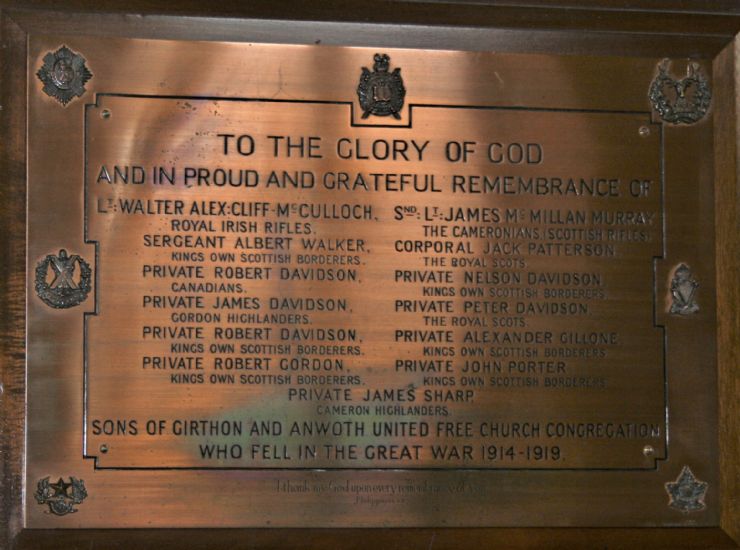
In 1954 there were 86 children attending Sunday School in the Rutherford Hall and 9 older children at Bible Class. There were also Sunday evening meetings arranged by Jack Patterson with help from Miss Scott and Dr Russell.
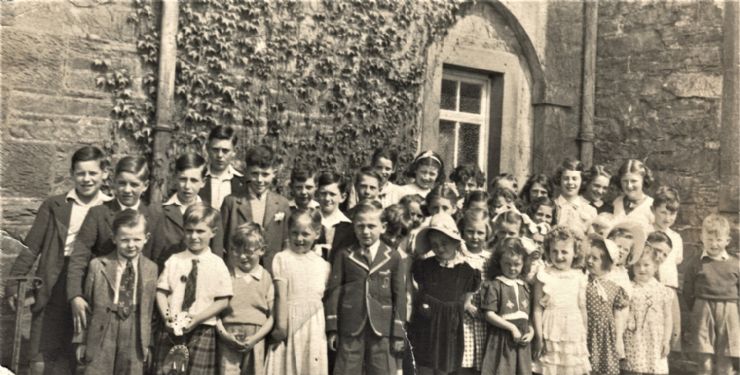
1952 Girthon Sunday School
Downstairs the meeting room was used by the Women's Guild, another church organisation.
Occasionally concerts were also held – such as Nativity Plays performed by the Sunday School and choir although the stage was not ideal as there was no back stage.
After the war years other organisations also used the hall - Boy Scouts and Cubs, Girl Guides and Brownies, the play group, dancing classes, choir practices and carpet bowlers were all regular users. It was used for meetings, dances, sales of work, jumble sales, and occasionally the Gatehouse Horticultural Show.
For many years during Gala week, an exhibition of local art work took place.
For a number of years Anwoth Books – a second hand book shop used the space before it moved the top floor of The Mill on the Fleet.
During this period Jim Campbell or Henderson (Slim Jim) was the hall keeper.
In 1962 the Church of Scotland decided to sell the Rutherford Hall and build a small hall next to Girthon Church, although this took a number of years to actually happen.
Rev. Lynch, the Roman Catholic priest was interested in buying the hall. Gatehouse Roman Catholics had been meeting upstairs at 10 Catherine Street for many years but the plan to buy the Rutherford Hall fell through.
In 1970 the building was given listed building status.
In early1981 the Kirk Session offered to sell the Rutherford Hall to the Community Council but the offer was declined as the they knew that the old school building at Gatehouse School would soon be available and would be a more suitable site for a Community Centre.
On 1st April 1981, antique dealers Roger and Lyn Hampshire bought the building. They converted it into 3 flats – 2 at the rear of the building (East & West Gables) and a Tower flat accessed via the original front door. There is also a flat in the basement.
The conversion also included 2 shop units at street level and to the front.
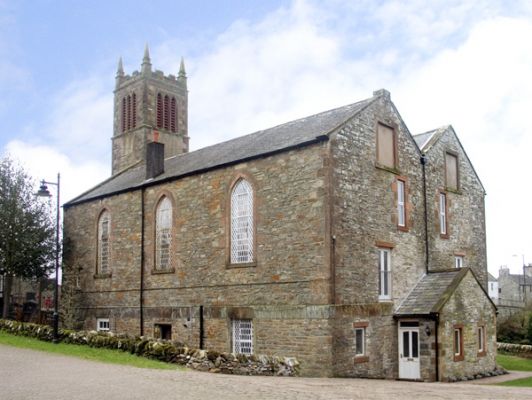
|
For a number of years the Hampshires ran an antique shop. In 1994 they opened an exhibition - a museum of Galloway life called 'As We Were'. |
Click here to see an
for the 'As We Were'
exhibition.
|
Click here to see the |
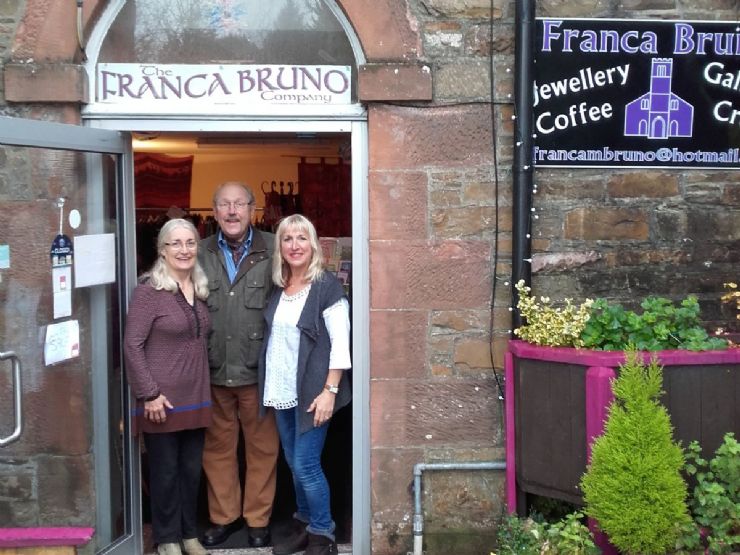
|
In 2019 Franca Bruno’s shop was replaced by 'The Crafty Crow'
They offer a vegan cafe with take-away home-made pizzas,
|
|
Flooding
Over the years the Rutherford Hall has been prone to flooding due to its proximity to the River Fleet,
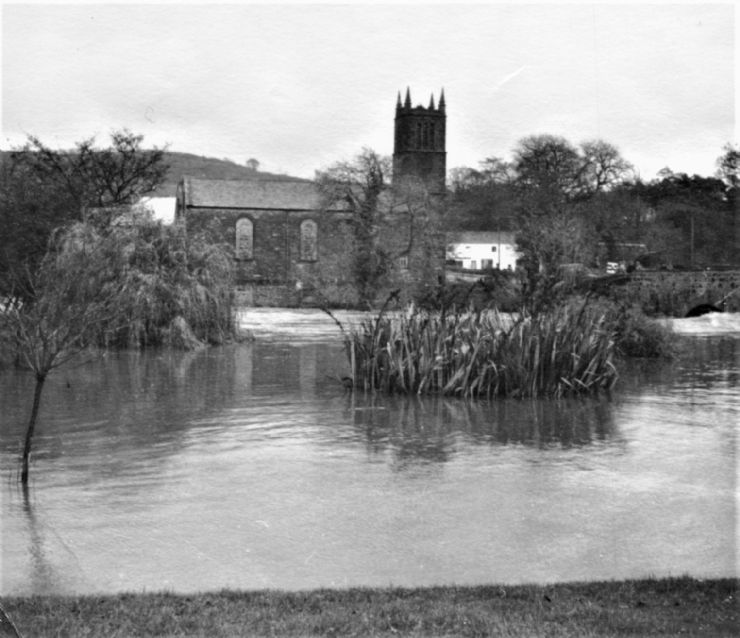
1940s Flooding
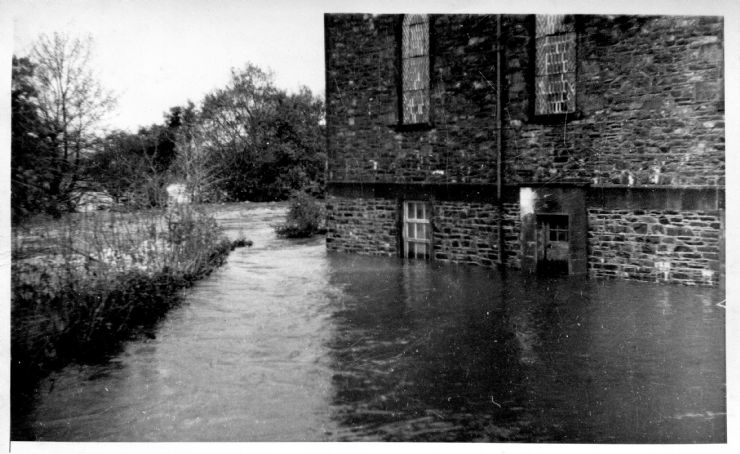
1954 Flooding
